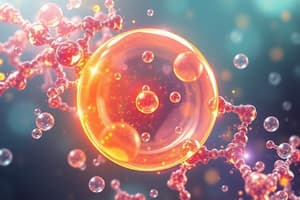Podcast
Questions and Answers
What is the Greek origin of the term 'lipids'?
What is the Greek origin of the term 'lipids'?
- Lipos means 'fat' (correct)
- Lipos means 'water'
- Lipos means 'sugar'
- Lipos means 'protein'
Which of the following is NOT a function of lipids in the body?
Which of the following is NOT a function of lipids in the body?
- Storing fat-soluble vitamins
- Acting as thermal insulator
- Forming the backbone of proteins (correct)
- Serving as a source of energy
What makes fats different from oils?
What makes fats different from oils?
- Fats are solid at room temperature, while oils are liquid (correct)
- Fats contain unsaturated fatty acids, while oils contain saturated fatty acids
- Fats are derived lipids, while oils are simple lipids
- Fats are liquid at room temperature, while oils are solid
Which type of simple lipids are esters formed from long-chain carboxylic acids and long-chain alcohols?
Which type of simple lipids are esters formed from long-chain carboxylic acids and long-chain alcohols?
What is the composition of fats like triacylglycerides?
What is the composition of fats like triacylglycerides?
What characterizes compound lipids?
What characterizes compound lipids?
What is the meaning of the Greek word 'eikos'?
What is the meaning of the Greek word 'eikos'?
Which compound is responsible for inducing contraction of the muscle in airways to the lungs?
Which compound is responsible for inducing contraction of the muscle in airways to the lungs?
What effect do prostacyclins have on blood vessels?
What effect do prostacyclins have on blood vessels?
Which compound is involved in regulating inflammation, blood pressure, and fever?
Which compound is involved in regulating inflammation, blood pressure, and fever?
What is the main mechanism of action for Paracetamol and Aspirin as described in the text?
What is the main mechanism of action for Paracetamol and Aspirin as described in the text?
Which enzymatic pathways lead to the synthesis of eicosanoids?
Which enzymatic pathways lead to the synthesis of eicosanoids?
Which type of cholesterol is known as the 'good' cholesterol?
Which type of cholesterol is known as the 'good' cholesterol?
What is the function of LDL particles in the bloodstream?
What is the function of LDL particles in the bloodstream?
How many types of lipoprotein particles are classified based on their density?
How many types of lipoprotein particles are classified based on their density?
Why do some doctors recommend aspirin to reduce the chance of heart attack or stroke?
Why do some doctors recommend aspirin to reduce the chance of heart attack or stroke?
What is the purpose of a lipid profile test?
What is the purpose of a lipid profile test?
Which lipoprotein is responsible for removing cholesterol from cell surfaces?
Which lipoprotein is responsible for removing cholesterol from cell surfaces?
Why are omega-3 and omega-6 fatty acids considered essential?
Why are omega-3 and omega-6 fatty acids considered essential?
What causes rancidity in oils and fats?
What causes rancidity in oils and fats?
Which type of fatty acids are particularly susceptible to oxidative rancidity?
Which type of fatty acids are particularly susceptible to oxidative rancidity?
What is the role of eicosanoids in the body?
What is the role of eicosanoids in the body?
What causes the unpleasant taste and smell associated with rancidity?
What causes the unpleasant taste and smell associated with rancidity?
Why are fatty acids like omega-3 and omega-6 important for human health?
Why are fatty acids like omega-3 and omega-6 important for human health?
What effect do unsaturated fatty acids have on their melting points compared to saturated fatty acids?
What effect do unsaturated fatty acids have on their melting points compared to saturated fatty acids?
How does the number of double bonds in unsaturated fatty acids affect their melting points?
How does the number of double bonds in unsaturated fatty acids affect their melting points?
Why are linoleic acid and α-linolenic acid considered essential fatty acids?
Why are linoleic acid and α-linolenic acid considered essential fatty acids?
How are linoleic acid and α-linolenic acid obtained by humans?
How are linoleic acid and α-linolenic acid obtained by humans?
What is the significance of linoleic and α-linolenic acid being referred to as omega fatty acids?
What is the significance of linoleic and α-linolenic acid being referred to as omega fatty acids?
What is the main reason that linoleic and α-linolenic acid cannot be synthesized in the body?
What is the main reason that linoleic and α-linolenic acid cannot be synthesized in the body?
Flashcards are hidden until you start studying
Study Notes
Lipids
- Lipids are organic compounds found in living organisms that are soluble in nonpolar organic solvents.
- Lipids have a variety of structures and functions, including fats, oils, waxes, cholesterol, other sterols, and most steroids.
Functions of Fat in the Body
- Makes food palatable
- Provides energy
- Acts as a thermal insulator and cushion around organs
- Stores fat-soluble vitamins (A, D, E, etc.)
- Forms the backbone of hormones and cell membranes
Classification of Lipids
- Lipids can be classified into three types: simple lipids, compound lipids, and derived lipids
Simple Lipids
- Esters of fatty acids with various alcohols
- Examples include:
- Fats: Esters of fatty acids with glycerol (e.g., triacylglycerides)
- Waxes: Esters of fatty acids with higher molecular weight monohydric alcohols (e.g., beeswax)
Compound Lipids
- Esters of fatty acids with alcohol and possessing additional groups
Essential Fatty Acids
- Two essential fatty acids that cannot be synthesized by the body: linoleic acid and α-linolenic acid
- These fatty acids must be obtained through diet or by consuming plants or animals that have consumed these plant fats
Omega Fatty Acids
- Omega-3 (ω3) and omega-6 (ω6) fatty acids are unsaturated essential fatty acids
- Examples include:
- Palmitoleic acid (16:1Δ9)
- Stearic acid (18:0)
- Oleic acid (18:1Δ9)
- Linoleic acid (18:2Δ9,12)
- α-Linolenic acid (18:3Δ9,12,15)
- Arachidonic acid (20:4Δ5,8,11,14)
- Eicosapentaenoic acid (20:5Δ5,8,11,14,17)
Rancidity of Oils
- Rancidity is a degradation process that modifies lipids, resulting in an unpleasant taste and smell
- Caused by incomplete oxidation or hydrolysis of fats and oils, or by bacterial action
Eicosanoids
- Hormones synthesized from essential fatty acids omega-3 and omega-6
- Examples include:
- Prostaglandins: regulate physiological responses such as inflammation, blood pressure, blood clotting, fever, and pain
- Thromboxanes: constrict blood vessels and stimulate platelet aggregation
- Leukotrienes: induce contraction of airway muscles and implicated in allergic reactions, inflammatory reactions, and heart attacks
- Prostacyclins: dilate blood vessels and inhibit platelet aggregation
Mechanism of Analgesic
- Aspirin and paracetamol are weak inhibitors of cyclooxygenase-1 (COX-1) and COX-2
- Inhibit thromboxane synthesis and prostacyclin production, leading to decreased blood clotting and anti-inflammatory effects
Lipoproteins and Lipid Profile
- Lipoproteins are particles that contain cholesterol, cholesterol esters, phospholipids, and proteins
- Classified into five types based on density: high-density lipoprotein (HDL), intermediate lipoprotein (IDL), low-density lipoprotein (LDL), very low-density lipoprotein (VLDL), and chylomicrons
- HDL is a cholesterol scavenger, removing cholesterol from membranes and delivering it back to the liver
- LDL is the "bad" cholesterol, while HDL is the "good" cholesterol
Studying That Suits You
Use AI to generate personalized quizzes and flashcards to suit your learning preferences.




